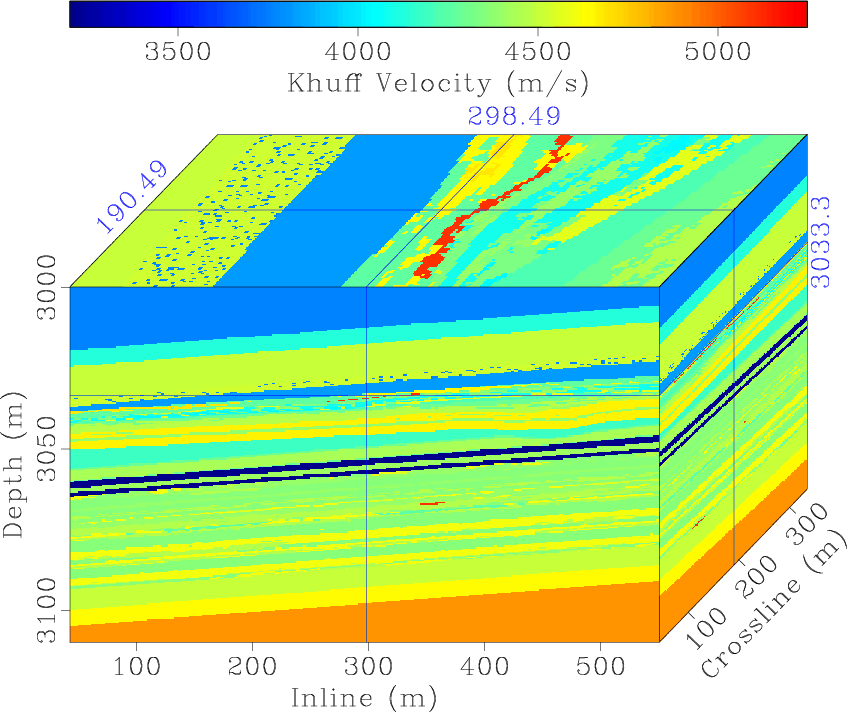 |
 |
 |
 | Carbonate reservoir characterization using seismic diffraction imaging |  |
![[pdf]](icons/pdf.png) |
Next: Method
Up: Synthetic Models
Previous: Ordovician Model
Our second model examines rocks equivalent to the Permian-Triassic Khuff-A and -B reservoirs, which crop out near Buraydah in central Saudi Arabia. An outcrop-based geocellular model 600 m  385 m
385 m  30 m was built to investigate the effect of small-scale carbonate reservoir heterogeneities on subsurface flow models (Janson et al., 2013). In addition, the 3D geological geocellular model was converted into a acoustic impedence (AI) model using laboratory velocity (Figure 2a) and density (Figure 2b) measurement from outcrop plugs. An average acoustic impedance value for each lithofacies present in the geological model was used to convert the lithofacies model into an impedance volume (Figure 2c) in order to maintain the realistic level and distribution of reservoir heterogeneities. Because of its limited size, the outcrop-based geocellular model was scaled up for seismic modeling by addition of a similar but simpler model of strata below it as well as acoustically constant buffer layers above and below to make the final model 110 m thick.
30 m was built to investigate the effect of small-scale carbonate reservoir heterogeneities on subsurface flow models (Janson et al., 2013). In addition, the 3D geological geocellular model was converted into a acoustic impedence (AI) model using laboratory velocity (Figure 2a) and density (Figure 2b) measurement from outcrop plugs. An average acoustic impedance value for each lithofacies present in the geological model was used to convert the lithofacies model into an impedance volume (Figure 2c) in order to maintain the realistic level and distribution of reservoir heterogeneities. Because of its limited size, the outcrop-based geocellular model was scaled up for seismic modeling by addition of a similar but simpler model of strata below it as well as acoustically constant buffer layers above and below to make the final model 110 m thick.



|
|---|
kvp,kden,kai
Figure 2. Khuff synthetic model: (a) velocity; (b) density; (c) acoustic impedance
|
|---|
![[pdf]](icons/pdf.png) ![[pdf]](icons/pdf.png) ![[pdf]](icons/pdf.png) ![[png]](icons/viewmag.png) ![[png]](icons/viewmag.png) ![[png]](icons/viewmag.png) ![[scons]](icons/configure.png)
|
|---|
 |
 |
 |
 | Carbonate reservoir characterization using seismic diffraction imaging |  |
![[pdf]](icons/pdf.png) |
Next: Method
Up: Synthetic Models
Previous: Ordovician Model
2015-03-25
![]() 385 m
385 m ![]() 30 m was built to investigate the effect of small-scale carbonate reservoir heterogeneities on subsurface flow models (Janson et al., 2013). In addition, the 3D geological geocellular model was converted into a acoustic impedence (AI) model using laboratory velocity (Figure 2a) and density (Figure 2b) measurement from outcrop plugs. An average acoustic impedance value for each lithofacies present in the geological model was used to convert the lithofacies model into an impedance volume (Figure 2c) in order to maintain the realistic level and distribution of reservoir heterogeneities. Because of its limited size, the outcrop-based geocellular model was scaled up for seismic modeling by addition of a similar but simpler model of strata below it as well as acoustically constant buffer layers above and below to make the final model 110 m thick.
30 m was built to investigate the effect of small-scale carbonate reservoir heterogeneities on subsurface flow models (Janson et al., 2013). In addition, the 3D geological geocellular model was converted into a acoustic impedence (AI) model using laboratory velocity (Figure 2a) and density (Figure 2b) measurement from outcrop plugs. An average acoustic impedance value for each lithofacies present in the geological model was used to convert the lithofacies model into an impedance volume (Figure 2c) in order to maintain the realistic level and distribution of reservoir heterogeneities. Because of its limited size, the outcrop-based geocellular model was scaled up for seismic modeling by addition of a similar but simpler model of strata below it as well as acoustically constant buffer layers above and below to make the final model 110 m thick.


